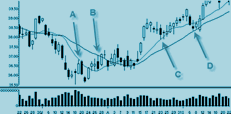THE MARKET TIMING VIDEO COURSE

Dear Trader,
It seems that everyone has their own unique method for investing in their future. Some people will buy shares in companies merely because they use their products on a regular basis. Others will buy gold and stash it under their floor boards. I have to confess that I’ve never done either of these things, but for some, the “investment” methods I just described do not seem far-fetched at all. On the other hand, the way that I invest has been one that has stirred up a great deal of controversy over the years. I am a “market timer.”
The concept of “market timing” is one that has been around for at least several hundred years, and probably several thousand in some form or another. The premise is that an investor can use tools and techniques at their disposal to optimize the times they enter or exit the markets in order to maximize the return on their investments, while minimizing their risk exposure.
Market timing has been gaining in popularity since the mid-90s, but anyone that watches a news channel that focuses upon market activity will quickly realize that the concept still hasn’t quite caught on in all circles.
On a visit to New York a couple of years ago, I was at the offices of one of the biggest financial news networks in the world and a senior-level producer asked me what some of the stocks were in my portfolio. Given that the topic was on longer term positions, I told him the symbol of my most recent acquisition.
“What do they do?” he asked.
“I have no idea,” was my reply.
“Well, what is the company?”
”I don’t know, I only know the symbol, but I can draw for you exactly what the chart looks like.” I was rather surprised that nearly everyone looked at me like I was from another planet. After a pause, another producer commented, “That seems a little unusual, don’t you think?” Unusual? Perhaps, but until that point in time, I had never really given it much thought! To me, the idea that a person could improve their returns on their investments by studying the underlying security made perfect sense, even though applying that knowledge properly can take a bit of work! Such incredulous reactions are less common these days, and you will find a lot more credit given to the concept of market timing, but a great deal of controversy remains. Perhaps the largest debate between market timers themselves has been which style of market timing is the best. There are two main types of “market timers.” Those who make up the first group call themselves “fundamental analysts”, while those who fall into the second category call themselves “technical analysts”.
Fundamental analysts try to identify and predict the cause of market moves and the logical price level a security should be trading at as a result of its intrinsic value. This value is determined through an analysis of the core characteristics of a security and can include anything from a company’s price-to-earnings ratio, the mental stability of a CEO, or a global-political crisis that might weigh upon the price of a commodity or a currency’s exchange rate. In other words, they look for the fundamental cause of price action.
There are many die-hard proponents for each of these two styles and even within the categories themselves there are many different approaches. While I certainly respect the fundamentalists, this style of trading tends to favor those who are looking to maintain long-term positions and for whom the shorter term fluctuations in a security’s price are not as relevant. When the data being released by a company or particular industry is questionable, however, a lot of the legitimacy for fundamental bias on a security can be eroded very quickly.
Before the housing bubble and the collapse of many of the nation’s largest and most-trusted companies in late 2007, fundamental analysis was often considered to be the more legitimate form of market timing. Gradually, however, even many of my more fundamentally-biased friends began to integrate technical analysis into their market timing techniques.
Unlike fundamental analysts, technical analysts do not care at all about what a security does or what the reasons are behind a price movement in the security. They care only about the price action itself. They believe that the reason that a security is at the price level it is at is already represented in the price of the security itself. Success as a technical analyst requires no knowledge or skill as it relates to understanding the fundamentals of a security. In fact, as strange as it may seem, one does not even need to know what the underlying security is or what it does in order to profit from the technical analysis of the security.
The premise of technical analysis is that human beings are creatures of habit ruled by fear, greed, and necessity and that the interaction between the three results in the prices fluctuations in an individual security, which can be represented in a graphical format.
Coming from a background in anthropology, and particularly archaeology, this seemed like a logical conclusion since I had studied everything from language development to migratory settlement patterns in just such a manner. Chartists are quite aware that there are reasons why markets move higher or lower, but we don’t believe that understanding them is necessary to predict where the market is heading next. For example, it may be a drought that is pushing a food source further north in a particular region, and hence the population is also moving in that direction. The cause, however, may not be recognized until after a great deal of study.
What first becomes apparent to the archaeologist is that a population is on the move and at some point that movement slows or comes to a halt. If an archaeologist sees that a population has moved from one location to the next, and is pushing further in a certain direction, it is possible to infer the areas to explore for further excavation. If the archaeologist waits to discover the reason that a move has taken place, however, before making an educated guess as to where the population has migrated to, then another team of archaeologists may beat them to the punch and establish the rights to excavate in the new locale.
Similarly, the fundamental reasons for a market move may not be apparent at the beginning of a market move. Often an upside price movement will begin prior to the realization that the fundamentals in a security have begun to reverse and favor such a move. If the trader waits for the fundamentals to be favorable, then he or she will often miss the most ideal entry price on a security.
No matter what caused prices to shift, establishing theories as facts is not an easy task. News stations that track market data are constantly trying to explain why moves take place, not from a technical standpoint, but from the standpoint of something that more people can relate to, such as an earnings warning, the latest gross domestic product data, or even just a trip overseas by a major political leader. It often amuses me that the moves that are attributed to reasons such as these will have often taken place before or quite awhile after the news itself. It quickly becomes apparent that the attempt to assign a reason to a price move in this manner is just based upon the human desire to have some sort of explanation and closure.
Despite what you may see on the History Channel, however, even the reasons behind most archaeological discoveries will often remain a mystery and the “best guesses” as to what many artifacts are and what their function is, or why people moved from one place to another, are often just that… best guesses. The more often you see things repeat, however, and the more variations you find of similar activity, the more accurate your assumptions will likely become when trying to locate additional examples of the same artifacts or activities.
This is where technical analysis really comes into play. It allows a trader to begin to track not only price movement itself, but to also start to have a feeling for how that type of price action unfolds. Even if the reasons why such moves occur might never be known from the point of view of a newscaster or the everyday Joe on the street, you can start to develop a sense for the technical reasons prices shift the way that they do.
Intriguingly, you can use the same chart reading skills you learn as a trader and apply them to the study of the natural sciences as well… or vice versa. I read an article a few months ago in a major science publication that was related to an environmentalist who studies the migratory movements and population growth and demise of a certain type of ocean fish. It amused me that the article included a description of how this man used the same analysis to trade the markets. To me this came as no surprise, but I bet it led to a lot of skepticism from the readership! Fish, however, must also adapt to their own environment, and while greed and fear may not be reasons that many would like to equate as being on the same level as human beings, they certainly possess the instinct to survive. After all, you are not likely to be able to swim up to a fish without it rushing to get out of your way. Likewise, if food is not very plentiful in one locale, they are going to seek out new feeding grounds
.“So how can I take this fishy analogy and use it to help me become a better trader?” you might be asking. Well, when it comes to technical analysis itself, there are a number of schools of thought as to what the best strategies and techniques are. Some are based upon technical indicators. Some are based upon “price patterns”, such as Bull Flags. Others are based upon phenomena such as morning gaps. My own understanding of the markets has evolved a great deal over the years, but over time I realized that there are several main traits within the movement of the price of a security that serve as the precursor to upcoming price moves. These traits are now what I consider to be the “building blocks” of price pattern development and the unique characteristics of each weighs heavily upon the future price move of a security.
I have divided these building blocks into five categories: pace, trend development, support and resistance, volume, and correction periods. I would assume that every technical analyst out there is familiar with trading based upon strategies, such as Bull Flags, triangle breakouts, etc. What most traders do not understand, however, is that these price patterns are not whole setups that take place in a snapshot in time. Two Bull Flags, for example, might look identical on a daily time frame and yet one succeeds while the other fails. The reason is not merely because a certain percentage of flags fail. It’s because there were core differences on some level between these two seemingly identical strategies. Those differences are a result of often unnoticeable traits within the larger flag patterns themselves. These traits are my Five Building Blocks of Price Development.
The composition of each of these Five Building Blocks of Price Development can influence everything from the percentage of success a strategy has, the average reward it will generate compared to its risk, and can even indicate which strategies will likely follow the current one as prices continue to evolve.
In this course, I have put together some of the most popular “trading patterns” utilized by market participants today, as well as some of my own. In each of the examples I will detail how my Five Building Blocks of Price Development influence the setup and outcome of each strategy. I will also provide you with step-by-step guidelines for utilizing my style of market analysis to improve your own results.
You will quickly realize that some of the core concepts that many traders are taught relating to technical analysis, such as a traditional Head-and Shoulders pattern, will actually hinder your success. Read and watch very carefully and see if you can recognize other mainstream concepts that can be improved through the use of my Five Building Blocks of Price Development.
As you progress through this course, notice that I have taken setups from multiple asset classes and time frames to include in this publication. That is because my style of market analysis is not limited to merely one or two markets or time frames! Once you have learned how to use my Five Building Blocks of Price Development, you will be able to take that knowledge and apply it to any market you favor!
When studying the patterns in this course, I recommend that you first read through each of the setups and the accompanying examples of the patterns one at a time. Be sure to also view the video portion for each strategy before moving onto the next.
Once you have made it through the course, begin compiling your own loose-leaf notebook or folder with charts that illustrate the patterns I have outlined and make a note of each of the pros and cons you can identify within each strategy according to my Five Building Blocks of Price Development. This will help you grow and develop a better understanding of the dynamics at play within each of the patterns, as well as discover where your greatest strengths lie!
All my best,

Toni Hansen
Testimonials for Toni Hansen
"Dear Toni, I want to thank you for sharing the knowledge and insights you have gained over the years as a professional trader. I would recommend your CD and mentoring to anyone serious about consistently making money in the market, regardless of market conditions. As an experienced investor who has watched you firsthand, it is clear that you are a world class trader. Thanks for helping me become a better trader." - Guy Allen, Florida
“I owe you so much when it comes to my development as a trader. You have been a guiding light... I will always look back on you as a key element in that success. Thank you so very much...” - Greg
“Anyone who is trading needs your guidance for the education of trading. Your education of trading aspects is the GREATEST thing I have ever used. I learned more in two weeks from you, than from any books I read. THANKS AGAIN!” - Clarence E. Austin
“I'm done for the day and am very pleased...I have taken all your calls and follow them to the T...the NQ ones that is (trade QQQQ) and I play the gaps in the morning also (I'll take the 71% chance anytime)...I have turned myself around...First time in months...Thank-you! ”- Richard Widen
“I hope that everyone truly understands just how fundamentally sound and accurate your market trading strategies and concepts are. I have been trading for quite some time, and I just want you to know that I have been so very impressed with your substance based upon sound trading fundamentals and not "fluff" THANK YOU...” - Randall Morrow





